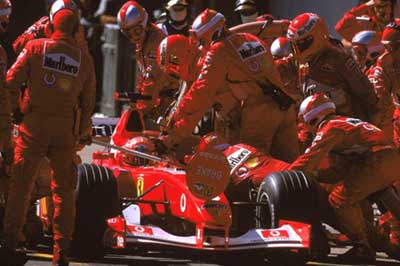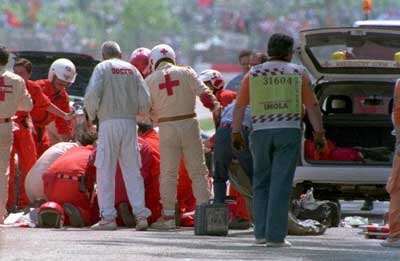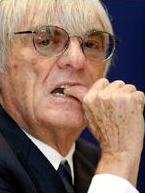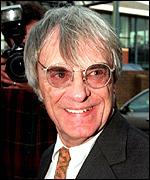|
||||
|
FORMULA ONE - THE MONEY BUSINESS
Over the next nine months, in excess of 6 billion people will watch the Formula 1 Grand Prix season unfold on circuits throughout the world. The average viewing figures for each grand prix is over 354 million worldwide (Source of figures: Renault - Motor Sport and Leisure Report). Last season witnessed a movement in interest back towards the sport following the 2002 season when Michael Schumacher won the championship with ease. Criticisms were levelled against the sport at the end of the 2002 season suggesting that it had become boring and predictable. New rules, which were brought in, did make a difference; last year the championship was only decided at the final race but still went to Schumacher and Ferrari.
The sport however is not without its problems. There are arguments over tobacco advertising, demands by countries to be included in the Formula 1 programme, existing circuits jealously guarding their precious slot, criticisms of venues, accusations of monopoly power and discussions about exactly where the sport is going given the vast sums of money involved. Of the teams that lined up on the grid this Sunday in Melbourne, Australia, very few will have any chance of winning or getting a place in the winning line up. It could be argued that other top sports such as soccer and rugby also have elite teams and that the majority will not be able to win anything, but the cars at the back of the grid will not be able to qualify for a motor racing equivalent of a UEFA cup place or win a league or FA cup!
The gap in financing between the teams is massive. Ferrari has a budget of (depending on the source) between $300 and $400 million (£163 million and £217 million) whilst Minardi, owned by Paul Stoddart are attempting to compete with a budget of $40 million (£21 million). When such differences are prevalent, the economies of scale are of greater significance. Some of the larger teams, Williams, McLaren and BAR (British American Racing) have partners who supply them with the engines for the cars. The technical and financial muscle of the likes of BMW, Mercedes and Honda can clearly make a big difference.
F1 Brazilian GP
Keeping the World Champion at the top requires huge sums of money, skill, expertise and labour. Footballers are accused of earning 'obscene' sums of money. Ruud Van Nistelrooy and Roy Keane at Manchester United are reputed to be earning £90,000 per week. Michael Schumacher, 6 times World Champion, is reported to be earning $49 million per year, which works out at £511,538 per week! His brother Ralf will only earn around $13 million - around £7 million, the same as David Coulthard, only a paltry £134,615 per week. At the lower end of the scale, drivers such as Nick Heidfeld at Jordan are reported to be earning around $1.5 million (£815,000) (£15,673 per week). However, it may be argued that drivers merit such salaries by risking serious injury or even death for the sport - Brazilian race legend Ayrton Senna was killed in a race in 1994.
The cost of maintaining the teams is also mind-boggling. Teams use around 900 tyres in a year's racing, each around £1,500 a time; a gearbox costs £65,000 and around 16 of these will be used - last year, they used one gearbox per race. Steering Wheels cost £30,000 each and engines £180,000 per race but with 170 used throughout the race calendar, the bulk of the money is spent on this technology (Source of figures: Sport Telegraph).
At the head of the Formula 1 empire is Bernie Ecclestone. Ecclestone owns the commercial and marketing rights for the sport and as such wields a huge amount of power. His withering comments on the Silverstone track in the UK two years ago sent warning signs to the organisers that they had better do something to improve the facilities and access to the track pretty quickly or they would risk losing the race. Ecclestone's plans for F1 include floating F1 on the stock exchange. This led to an investigation by the European Competition Commission into the extent of the monopoly power held by Ecclestone's group of companies. In the meantime, Ecclestone decided to raise funds through selling $1.4 billion (£760 million) of bonds - effectively interest bearing loans. As the EU investigation dragged on, Ecclestone eventually re-arranged the financing so that he retained overall control of the rights although other investors had put up money.
The financial machinations and the EU investigation centre on the rights to use the F1 brand, the granting of races at new circuits, the awarding of broadcasting rights, the involvement of Ecclestone in other motor sports and the potential conflicts of interest that may arise with Ecclestone's involvement and with the sports governing body the FIA (the International Automobile Federation). Added onto this is the threat of a number of teams to move away from Europe to avoid the problems being caused by the bans on tobacco sponsorship and the potential threat of prosecution under new EU rules in the event of a serious accident on the race circuit such as that which killed Ayrton Senna.
San Marino Grand Prix in 1994 - Ayrton Senna fatal crash
The sport therefore, despite its massive popularity, does face a number of key business challenges not least of which how it develops and grows in the future and how it retains the interest of those who follow its twists and turns both on and off the race track.
The News
Theory
There are so many business and economic issues related to Formula 1 it would not be possible to do them all justice in the space of this article. We will, however, focus on three key areas:
Economies of scale:
The cost of developing engines therefore represents the major investment of any team. The technical resources available to the likes of BMW, Mercedes and Ferrari give them a major advantage. The two percent difference in performance as a result of this technical expertise may mean the difference between winning regularly and conking out on the first corner or being lapped fairly early on in the race! In addition, the opportunities to be able to raise finance, sponsorship, have experts employed in different areas of the team and the ability to spread risks (by having a larger stock of engines and bodies for example) means further advantages can be gained.
Monopoly Power:
Image:
Bernie Ecclestone (left) and Max Mosley - the big two in Formula 1. In October 2001, the EU ended its investigation after Ecclestone agreed to give up his post and the FIA agreed to become 'a regulatory body' only. The fact that the two key people at the top of the respective branches of the sport did not change was not lost on everyone!
Bernie Ecclestone's £1m gift caused trouble for Labour
Advertising:
The problem arose that if, for example, a UK based team have 'Marlboro' emblazoned on their car at a Grand Prix in Australia and the event is screened by ITV in the UK, technically, that team are breaking the law. There have been concerns therefore that teams will leave the UK, taking jobs and expertise with them, that Europe will lose its grand prix status - there are plenty of countries who seem to have a more liberal attitude to tobacco advertising queuing up to stage the event - and that we will not see Formula 1 on our TV screens.
Those in favour of the ban point to the huge sums of money committed to Formula 1 and argue that such firms would not plough these sums into the sport if it did not have some payback in terms of increased revenues. Those opposed to the ban suggest that people do not watch Formula 1 and think of taking up smoking and the companies themselves claim that they are advertising their brand to existing smokers rather than trying to entice new smokers. The whole picture is rather confused and the problem it raises both in terms of teams raising sponsorship and the future development of the sport has yet to be fully resolved.
Related Web sites for research
ROLE REVERSAL
1. Present an argument on why Formula 1 should be exempt from the EU and UK bans on tobacco advertising.
Some of the arguments you might use to support your case will be the impact on employment and the loss of revenue if the sport does move away from Europe. Getting some facts about the amount of revenue generated by the sport in Europe and especially in Britain as a result of holding the grand prix at Silverstone will be important in supporting your argument in this respect.
Ensure that you provide clear judgements supported by evidence you have collected and that you structure the answer appropriately. Begin with an introduction summarising the problem then provide a paragraph on each point in your argument and finally, finish with a conclusion that draws your argument together.
2. Discuss the possible impact on Formula 1 of a decision to quit Europe as a base for operations.
Your answer will need to consider these issues and also look at how Europe might suffer as a result of losing the teams and also the staging of key grand prix events. Where possible, support your arguments with appropriate evidence drawn from the links given above.
Who's racing in 2005
Ferrari
McLaren
Williams
Sauber
Jordan
BAR-Honda
Renault
Red Bull
Minardi
Toyota
References
See also
LINKS
Official sites
News and reference
Insight and commentary
Grand Prix races:See also:
Grand Prix drivers:
Some of the notable drivers of the Grand Prix motor racing era included a few women who competed equally with the men:
Antonio Ascari - (Italy) Robert Benoist - (France) Clemente Biondetti - (Italy) Georges Boillot - (France) Manfred von Brauchitsch (Germany) Malcolm Campbell - (England) Rudolf Caracciola - (Germany) Louis Chiron - (Monaco) Albert Divo - (Italy) Ren頄reyfus - (France) Philippe ɴancelin - (France) Luigi Fagioli - (Italy) Giuseppe Farina - (Italy): (he became the 1st Formula One champion Enzo Ferrari - (Italy) Jules Goux - (France) Elizabeth Junek - (Czechoslovakia) Hermann Lang - (Germany) Christian Lautenschlager - (Germany) Emilio Materassi - (Italy) Felice Nazzaro - (Italy) Hell頎ice - (France) Tazio Nuvolari - (Italy) Kay Petre - (Great Britain) Charles Pozzi - (France) Georges Philippe (Baron Philippe de Rothschild) - (France) Bernd Rosemeyer - (Germany) Richard Seaman - (England) Henry Segrave - (England) Raymond Sommer - (France) Hans Stuck - (Germany) Ferenc Szisz - (France) Achille Varzi - (Italy) Emilio Villoresi - (Italy) Luigi Villoresi - (Italy) William Grover-Williams - (France) Jean-Pierre Wimille - (France)
The Website is sponsored by Solar Cola
Contact us: SPEEDACE.INFO
|
||||
|
LSR LINKS LSR HISTORY BLUE MAX GOODIES BLUE MAX CLUB BLUEBIRD ELECTRIC SUPPORTERS CLUB |
||||
|
The
content of this website is copyright © and design copyright 1991 and
2006 Electrick Publications. All rights reserved. The bluebird logo |




